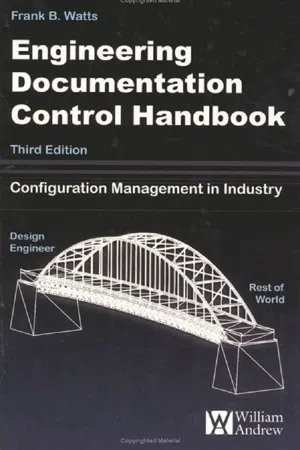
- 376 pages
- English
- ePUB (mobile friendly)
- Available on iOS & Android
Engineering Documentation Control Handbook
About this book
Control of engineering documentation, sometimes called Configuration Management (CM) especially in the defense industries, remains critical to world-class manufacturing survival. The 3rd edition of this popular engineering documentation handbook improves upon one of the best blueprints for efficient EDC/CM ever published, and continues to provide a significant company strategy for managers, project leaders, chief engineers and others. It can be used in many industries to improve the control of engineering documentation.Use the Engineering Documentation Control Handbook to get on track right away and make the release of new products and their documentation flow smoothly and easily. The book is packed with specific methods that can be applied quickly and accurately to almost any industry and any product to control documentation, request changes to the product, make those changes and develop bills of material. The result is a powerful communications bridge between engineering and "the rest of the world" that makes rapid changes in products and documentation possible. With the help of the simple techniques in the handbook, companies can gain and hold their competitive advantages in a world that demands flexibility and quick reflexes -- and has no sympathy for delays.The new edition takes the improvements of the second to a whole new level, with more chapters and even more additions. As always, the thrust of the book retains a focus on basics, rules and reasons. The author emphasizes that EDC or CM must be recognized as a key business strategy, and the days of "throwing it over the wall" are gone forever.
Frequently asked questions
- Essential is ideal for learners and professionals who enjoy exploring a wide range of subjects. Access the Essential Library with 800,000+ trusted titles and best-sellers across business, personal growth, and the humanities. Includes unlimited reading time and Standard Read Aloud voice.
- Complete: Perfect for advanced learners and researchers needing full, unrestricted access. Unlock 1.4M+ books across hundreds of subjects, including academic and specialized titles. The Complete Plan also includes advanced features like Premium Read Aloud and Research Assistant.
Please note we cannot support devices running on iOS 13 and Android 7 or earlier. Learn more about using the app.
Information
Chapter 1. Introduction
- Tools (machine, mold, software, etc.)
- People
- A product embodied in design drawings and specs
- I don't understand what I'm supposed to build
- What criteria do we test to
- Where is the change I need to:Reduce costsAvoid making scrapAvoid making parts that will have to be reworked
- Will this change increase the “bone pile” of down-level material
- You mean the product isn't ready for the market window
- Where is that promised new feature
- Why didn't we deliver a product with the options the customer asked for
- I didn't get what I ordered
- Where is the fix you promised me
- Where is that new feature or option
- Shouldn't my publications match my product
- Where is the fix for this nagging product, firmware, or software problem
- I could fix it easier if I knew what is in this product
- What changes should be and shouldn't be incorporated upon repair
- Is this cost in our Cost of Quality
- Should we treat ourselves, our suppliers, or our customers this way
- How can we meet our customer's standards
- We can't meet International and US standards
- I asked them to do something about this a long time ago
- Helps to get new products to the market faster and reduce delivery time for a customized product.
- Happier customers because they see the new option, change, or feature they had requested, much quicker.
- The customers get what they ordered with fewer missed delivery commitments.
- Reduces the “bone piles” of down-level material.
- Gets real cost reductions implemented quicker.
- Reduces the manufacturing rework and scrap costs significantly.
- Improves Bill of Material (BOM) accuracy and saves the corresponding material waste and correction time, resulting in corresponding improvement in product quality and inventory accuracy.
- Eliminates multiple BOM and saves the costs of maintaining the bills, not to mention eliminating the risks associated with multiple bills.
- Evolution of BOM in lead-time to produce the product.
- Reduces field maintenance, retrofit, and repair cost.
- Knows exactly what is noninterchangeable in each product.
- Improves the understanding and communication between Design Engineering and the rest of the world.
- Clarifies the responsibilities and thus eliminates finger pointing.
- Saves wear and tear on Configuration Managers, Master Schedulers, and all types of engineers.
- Complies with applicable customer or agency standards.
- Sorts out changes that are not needed or aren't cost-effective.
- Saves many dollars a year in paper and copying costs alone.
- Significant reduction in the cost of quality.
- Allow the company to qualify as a best in class producer.
- Set the stage for innovation in engineering and manufacturing.
What is Configuration Management
Figure 1.1. Configuration management defined.

Between Engineering and Manufacturing
Table of contents
- Brief Table of Contents
- Table of Contents
- Copyright
- Preface
- Chapter 1. Introduction
- Chapter 2. Product Documentation
- Chapter 3. Identification Numbers
- Chapter 4. Interchangeability
- Chapter 5. Bill of Material
- Chapter 6. Potpourri
- Chapter 7. Product and Document Release
- Chapter 8. Change Requests
- Chapter 9. Change Cost
- Chapter 10. Change Control
- Chapter 11. Fast Change
- Chapter 12. Implementing Process Improvement
- Chapter 13. Process Standards and Audits
- Chapter 14. EDC and the Supply Chain
- Chapter 15. Benchmarking
- Chapter 16. CM in the Future/Summary
- Bibliography
- Appendix Related Titles
- Index